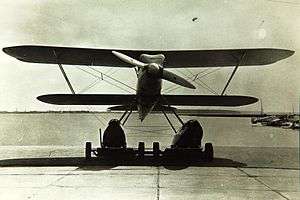Heinkel He 49
| He 49 | |
|---|---|
 | |
| Role | Fighter |
| Manufacturer | Heinkel |
| Designer | Günter brothers |
| First flight | November 1932 |
| Primary user | Luftwaffe |
| Number built | 4 |
| Variants | Heinkel He 51 |
The Heinkel He 49 was a German single-bay, single-seat biplane of mixed construction armed with two machine guns. Four designs were made, the He 49a, He 49b, He 49c, and the He 51 which went on to become a Luftwaffe fighter.
Production history
The first prototype, the He 49a, was flown in November 1932, and the second prototype, the He 49b, followed in February 1933, with a modified fuselage to make it 40 cm (16 in) longer. This was later turned into a floatplane, the He 49bW, and the third prototype, the He 49c, had a different engine. The He 49d went on to become the He 51, a fighter used during the Spanish Civil War which continued in service as an advanced trainer and ground-attack aircraft into the early years of World War II.
Operational history
All variants - apart from the He 51 - were just prototypes, and were never deployed.
Specifications (Heinkel He 49b)
General characteristics
- Crew: One
- Length: 8.24 m (27 ft 0⅓ in)
- Wingspan: 11.00 m (36 ft 1 in)
- Height: ()
- Wing area: 27.20 m² (292.79 ft²)
- Loaded weight: 1,950 kg (4,299 lb)
- Powerplant: 1 × BMW VI 6.0 twelve cylinder water-cooled engine, 515 kW (690 hp)
Performance
- Maximum speed: 325 km/h (202 mph) 302 km/h at 3,500 m (188 mph at 11,485 ft)
- Time to 1,000 m: 1.65 minutes
Armament
- Guns: 2 × fixed, forward-firing 7.92 mm (.312 in) machine guns
Bibliography
| Wikimedia Commons has media related to Heinkel He 49. |
- William Green and Gordon Swanborough. The Complete Book of Fighters. Colour Library Direct, Godalming, UK: 1994. ISBN 1-85833-777-1.